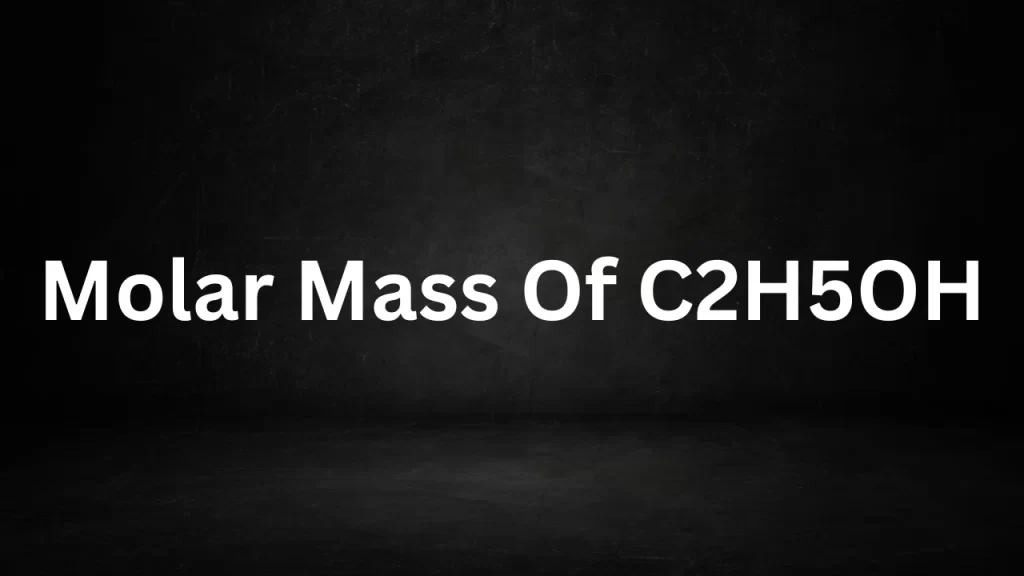Molar Mass Of C2H5OH
Molar Mass Of C2H5OH: The molar mass of a chemical compound is a crucial concept in chemistry. It represents the mass of one mole of that compound and is expressed in grams per mole (g/mol).
Calculating the molar mass of a compound is fundamental for various applications in chemistry, such as determining the quantity of reactants and products in chemical reactions. In this article, we will explore the calculation of the molar mass of C2H5OH, which is the chemical formula for ethanol, a widely-used alcohol in beverages, industry, and research.

Molar Mass Of C2H5OH
Molar Mass and its Significance
The molar mass of a compound is the sum of the atomic masses of all the atoms present in its chemical formula. It is calculated using the atomic masses of each element as they appear in the formula, taking into account the number of atoms of each element.
In the case of ethanol (C2H5OH), the molar mass calculation involves adding up the atomic masses of carbon (C), hydrogen (H), and oxygen (O) in the given ratio.
Atomic Masses of Elements in C2H5OH
To calculate the molar mass of C2H5OH, we need to know the atomic masses of the elements it contains:
- Carbon (C) has an atomic mass of approximately 12.01 g/mol.
- Hydrogen (H) has an atomic mass of approximately 1.01 g/mol.
- Oxygen (O) has an atomic mass of approximately 16.00 g/mol.
Calculating the Molar Mass of C2H5OH (Ethanol)
The chemical formula C2H5OH indicates that there are two carbon atoms (C), six hydrogen atoms (H), and one oxygen atom (O) in one molecule of ethanol (C2H5OH).
To calculate the molar mass, we sum the atomic masses of these elements, taking into account their respective quantities in one molecule of ethanol:
Molar Mass of C2H5OH = (2 × Atomic Mass of C) + (6 × Atomic Mass of H) + (1 × Atomic Mass of O)
Molar Mass of C2H5OH = (2 × 12.01 g/mol) + (6 × 1.01 g/mol) + (1 × 16.00 g/mol)
Mol Mass of C2H5OH = 24.02 g/mol + 6.06 g/mol + 16.00 g/mol
Mol Mass of C2H5OH ≈ 46.08 g/mol
So, the molar mass of ethanol (C2H5OH) is approximately 46.08 grams per mole (g/mol).
Significance of Molar Mass in Chemistry
The molar mass of a compound is a critical parameter in various aspects of chemistry:
- Stoichiometry: It is essential for balancing chemical equations, determining reactant and product quantities, and predicting the outcomes of chemical reactions.
- Concentration: In solutions, mol mass is used to calculate the concentration of a solute, which is vital in analytical chemistry and laboratory experiments.
- Chemical Analysis: Molar mass helps identify and quantify unknown compounds through techniques such as mass spectrometry and gas chromatography.
- Determining Molecular Weight: It provides valuable information about the size and weight of molecules, which is crucial in polymer chemistry and material science.
- Mole Concept: It relates the mass of a substance to the number of moles, facilitating the conversion between mass and moles in chemical calculations.
Conclusion
The mol mass of a compound, such as C2H5OH (ethanol), is a fundamental concept in chemistry. It represents the mass of one mole of that compound and is calculated by summing the atomic masses of the elements in its chemical formula. In the case of ethanol, its molar mass is approximately 46.08 g/mol. Understanding molar mass is essential for various applications in chemistry, including stoichiometry, concentration calculations, chemical analysis, and the determination of molecular weights, making it a cornerstone of chemical science.
Read More
- Molecular Weight of Co2
- Molecular Mass of Water
- Difference Between Cyclone And Hurricane
- Molecular Weight Of Na
- Molecular Mass Of O2
Frequently Asked Questions (FAQs) Molar Mass Of C2H5OH
What is the molar mass of C2H5OH (ethanol)?
The mol mass of ethanol (C2H5OH) is approximately 46.08 grams per mole (g/mol). This value is calculated by summing the atomic masses of the carbon (C), hydrogen (H), and oxygen (O) atoms in one molecule of ethanol.
How is the molar mass of C2H5OH calculated?
The mol mass of C2H5OH is calculated by adding up the atomic masses of its constituent elements in the given ratio. For ethanol, it’s (2 × Atomic Mass of C) + (6 × Atomic Mass of H) + (1 × Atomic Mass of O), which results in approximately 46.08 g/mol.
Why is knowing the molar mass of C2H5OH important in chemistry?
The molar mass is crucial in chemistry for various reasons, including stoichiometry, balancing chemical equations, determining concentrations in solutions, identifying unknown compounds, and understanding molecular weights in chemical reactions and material science.
What is the significance of the molar mass in stoichiometry?
In stoichiometry, molar mass is essential for balancing chemical equations and determining the quantitative relationships between reactants and products. It helps calculate the amount of substance in moles based on mass or vice versa.
How can the molar mass of C2H5OH be used in practical applications?
The molar mass of ethanol is used in various applications, such as determining the alcohol content in beverages, calculating the amount of ethanol needed in chemical reactions, and ensuring the proper mixing of fuel blends, like ethanol and gasoline.